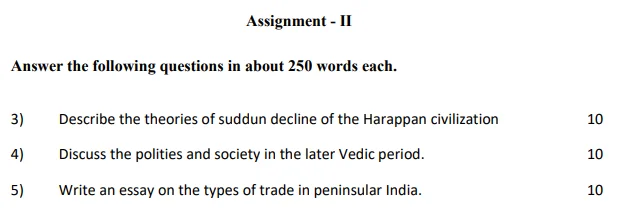BHIC 131 IGNOU Solved Assignment 2023-24 (free) Part -2

BHIC 131 IGNOU Solved Assignment 2023-24 (free) Part -2
Experience academic excellence with our BHIC 131 IGNOU Solved Assignment 2023-24 (free) Part -2! Dive deeper into historical concepts while adhering to guidelines and word limits. Achieve top scores and excel in your term-end exams. Elevate your historical understanding—secure your BHIC-131 IGNOU Assignment 2 solution now!

3) Describe the theories of sudden decline of the Harappan civilization
Ans. The sudden decline of the Harappan civilization, also known as the Indus Valley Civilization, remains a subject of scholarly debate among archaeologists and historians. Several theories have been proposed to explain its collapse, although no definitive explanation exists due to the lack of conclusive evidence. Here are some prominent theories:
Also Read This: BHIC 131 IGNOU Solved Assignment 2023-24 (free) Part -1
1. Environmental Factors: One theory suggests that environmental changes, such as a shift in river courses, changes in climate patterns, or natural disasters like floods or droughts, could have disrupted the agricultural systems that sustained the civilization. This could have led to resource scarcity, social upheaval, and the abandonment of cities.
2. Aryan Invasion or Migration: Some scholars propose the arrival of Indo-Aryans, possibly through invasion or migration, as a reason for the decline. This theory suggests that conflicts or the imposition of a new culture and social order by incoming groups might have contributed to the collapse of the Harappan cities.
Also Read This: Check BGDG 172 IGNOU solved assignment 2023-24 (Free)
3. Internal Decline or Socio-political Factors: Internal issues like social unrest, conflicts among ruling elites, or economic instability within the civilization could have weakened the centralized authority, leading to the decline. This theory emphasizes factors like the breakdown of trade networks, infrastructure decay, or shifts in societal organization.
4. Cultural Change or Integration: Another perspective suggests that the Harappan civilization did not completely collapse but rather transformed due to gradual cultural changes or integration with surrounding cultures, leading to the decentralization of urban centers.
5. Epidemics or Health Issues: Some researchers propose the occurrence of epidemics or health crises as contributing factors. The spread of diseases or health-related challenges might have weakened the population, impacting social cohesion and urban life.
Also Read This: Check BSOG 173 IGNOU solved assignment 2023-24 (Free)
Despite these theories, the exact cause of the Harappan civilization’s decline remains uncertain, partly due to the lack of comprehensive archaeological evidence and the complexity of ancient societies. It’s possible that a combination of multiple factors, rather than a single cause, contributed to its downfall. Ongoing archaeological excavations and research continue to shed light on this intriguing ancient civilization, but a definitive answer to its collapse remains elusive.
4) Discuss the politics and society in the later Vedic period.
Ans. The later Vedic period (c. 1000 BCE to 600 BCE) was a transformative phase in the socio-political landscape of ancient India, witnessing changes in governance, social structure, and religious developments.
Also Read This: Check top Begae 182 IGNOU solved assignment 2023-24 (Free)
Politics:
1. Emergence of Mahajanapadas: The later Vedic period marked the rise of larger territorial states known as Mahajanapadas, replacing the earlier Janapadas. These Mahajanapadas were more structured and organized, led by powerful rulers who exercised control over territories and cities.
2. Centralized Governance: The authority of kings became more prominent. Kingship was often hereditary, and rulers exercised power through administrative systems, councils (Sabha and Samiti), and military forces.
Society:
1. Varna System: Social stratification became more pronounced with the establishment of the varna system. This system categorized society into four main varnas: Brahmins (priests), Kshatriyas (warriors), Vaishyas (merchants/traders), and Shudras (laborers). Varna was determined by occupation and birth, forming the basis of social hierarchy.
Also Read This: Discover BPAG 174 ignou solved Assignment (Free) 2023-24
2. Urbanization and Craft Specialization: Urban centers began to develop, fostering specialized crafts, trade, and diversified economic activities. Towns and cities emerged as centers of commerce and cultural exchange.
3. Religious Developments: The later Vedic period witnessed the composition of Brahmanas and Aranyakas, texts detailing rituals and religious practices. The Upanishads, philosophical treatises exploring spiritual concepts, also emerged during this period.
4. Women’s Roles: Patriarchal norms persisted, restricting women primarily to domestic roles. However, some Rigvedic hymns continued to portray women in respected positions.
The later Vedic period laid the groundwork for significant socio-political changes in ancient India. The emergence of Mahajanapadas, the establishment of social stratification through the varna system, urbanization, and religious developments were pivotal in shaping the subsequent evolution of Indian society and governance.
Also Read This: BANC-131 IGNOU Solved Assignment 2023-24 (free) Part 1
5) Write an essay on the types of trade in peninsular India.
Ans. Peninsular India historically engaged in various types of trade due to its strategic geographical location and rich resources. These trades played a crucial role in shaping the region’s economy, culture, and interactions with other civilizations.
1. Maritime Trade: Peninsular India’s extensive coastline facilitated maritime trade. Ports like Kaveripattinam, Bharuch, and Tamralipta were centers of commerce, connecting the region with trade networks across the Indian Ocean. Spices, textiles, precious stones, and other goods were exported, while imports included luxury items, metals, and cultural influences.
2. Overland Trade Routes: Peninsular India had well-established overland trade routes connecting inland regions with neighboring kingdoms and empires. The Grand Trunk Road, connecting northern and southern India, facilitated the movement of goods and cultural exchange. These routes allowed trade in textiles, grains, spices, and other commodities.
3. Interregional Trade: The region’s diverse topography and climate led to the production of unique goods in different areas. Southern regions were known for spices like pepper and cardamom, while the Deccan Plateau produced precious stones, textiles, and iron. This interregional trade promoted economic diversity and cultural exchange.
Also Read This: BANC-131 IGNOU Solved Assignment 2023-24 (free) Part 2
4. Inland Waterway Trade: Rivers like the Godavari, Krishna, and Kaveri served as important inland waterways for trade within the peninsula. They facilitated the transportation of goods, fostering trade between different regions.
5. Cultural and Religious Trade: Besides commercial exchange, trade also facilitated the dissemination of cultural and religious ideas. Buddhism and Jainism, for instance, spread through trade routes, influencing art, architecture, and religious practices.
Overall, the various types of trade in peninsular India contributed to its economic prosperity, cultural richness, and integration with other civilizations. These trade networks played a significant role in connecting the region with the broader world, fostering cultural diffusion and economic growth.
Also Read This: BANC-131 IGNOU Solved Assignment 2023-24 (free) Part 3







